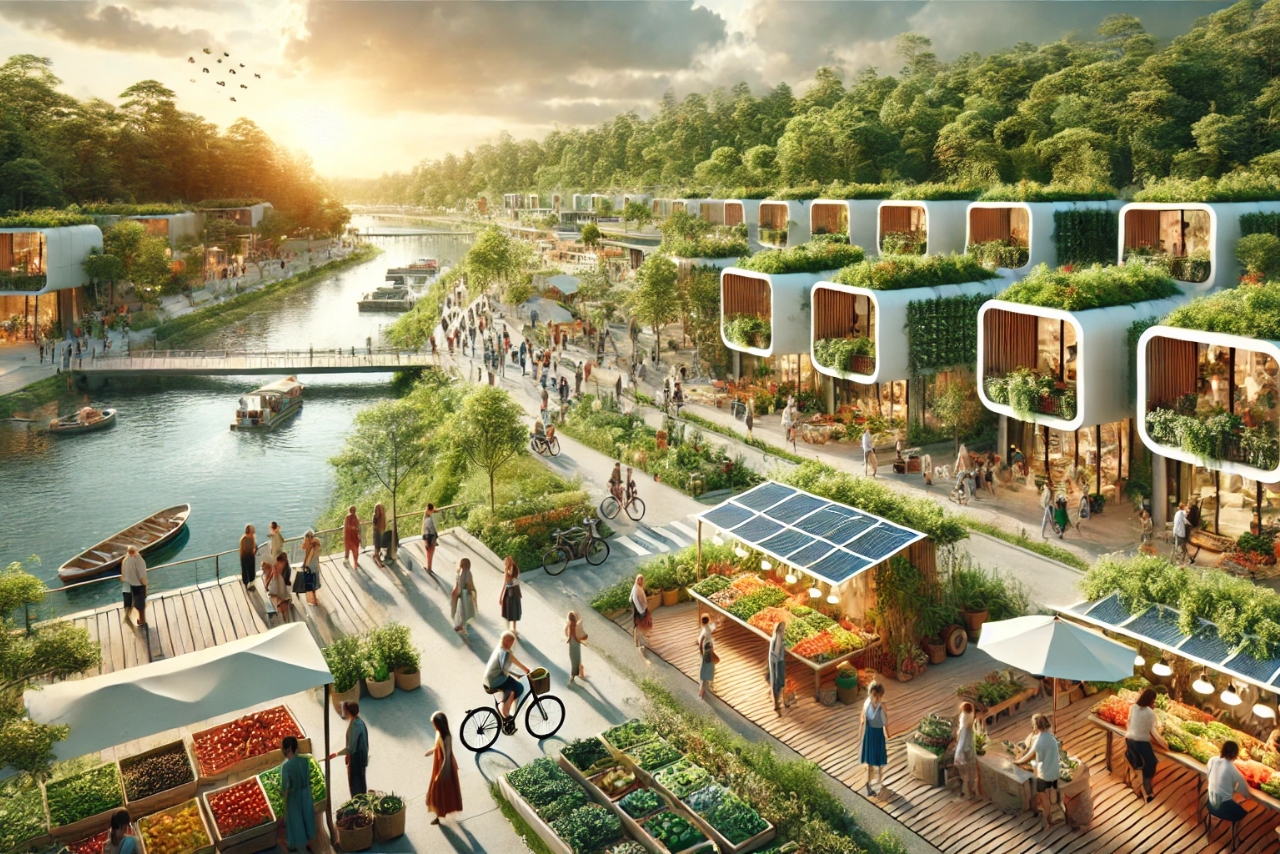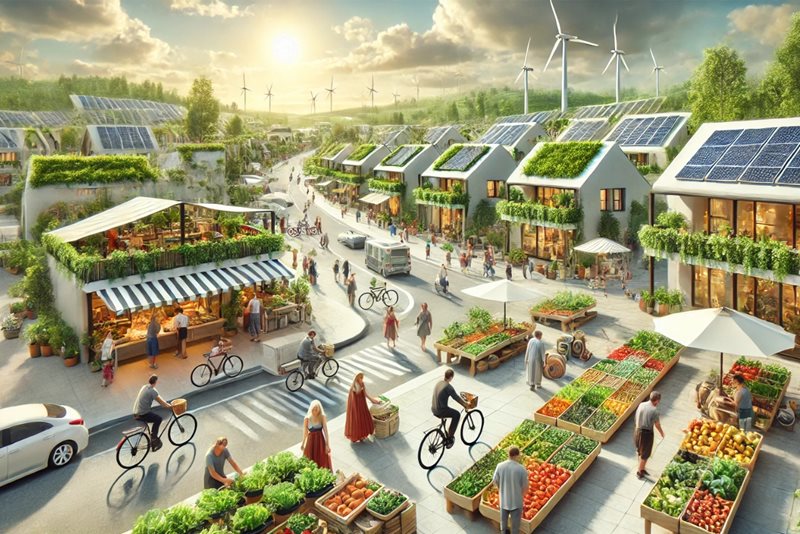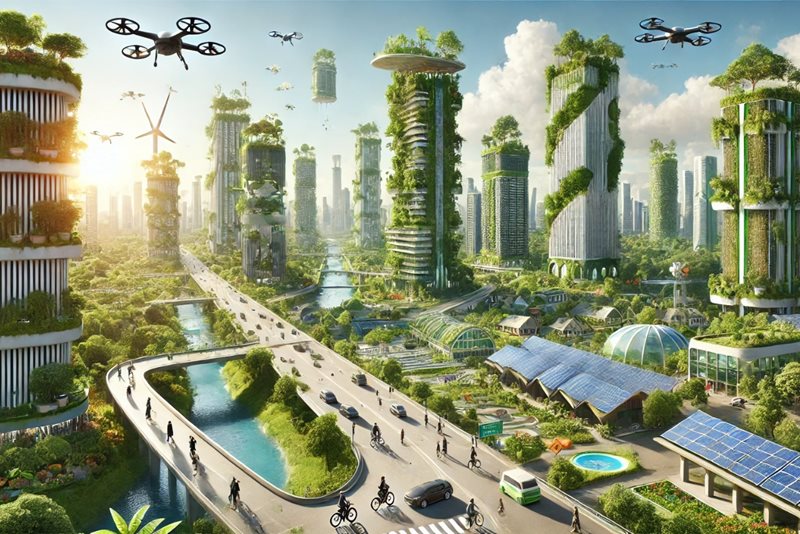Climate futurism is the sustainability theme of the month

February vision
“Thank you all for coming to this year’s Campus Town Visioning Workshop, as it is a momentous day in our community today. February is here, winter is fading, and the retreat is coming to an end, so it’s time to plan where we want to be on our journey together in 2055.
I ask you all to draw a Dixit card, get lost in the picture and think: what would it be like to live in such a world? Does the image make you feel good or bad? What would it mean for our community?
Once you have this, choose which of our community spaces best fits the vision you have imagined. The community climate garden? The clothing repair shop? The cult coffee? The meditation forest or the reservoir pond? Perhaps you would develop Agora, the centre of our democracy, with your vision?
The point is to let your imagination run wild. Don’t worry now about the resources, what the neighbours will think, what the perceived social expectations are. What matters is that the image means something to you, and that you would get out of it. Don’t let expectations stop you from innovating, from becoming yourself.
When you’re ready, meet us back here at three. We’ll put together what we’ve got, and the project teams will be formed. I’m sure you’ve grown fond of last year’s team members, but remember, working with new people for a common goal gives a lot of new impulses and power.”

Source: ChatGPT
What is climate futurism?
Climate futurism is an approach that responds to future climate challenges with innovative technological and social solutions. It is not only focused on sustainability, but also on a positive vision of a future in which humanity can adapt and thrive despite or in spite of the impacts of climate change,
says ChatGPT when asked to explain what climate futurism is. But the AI doesn’t stop there, it immediately brings up some specific features:
- Positive vision – It focuses not only on the consequences and threats of the climate crisis, but also on the innovative opportunities for mitigation and adaptation.
- Technological innovation – It focuses on developments such as renewable energies, carbon capture, novel foods (e.g. precision fermentation or cell culture) or sustainable architecture, but not limited to these, reducing demand and consumpis also important.
- Social and cultural transformation – Climate futurism relies not only on technology, but also on new economic models (e.g. circular economy), community solutions and social attitudinal change, including degrowth or doughnut economics.
- An interdisciplinary approach – Building on collaboration between science, art, business and politics to find complex and creative solutions.
- Sustainable urbanisation and architecture – Focuses on the development of smart cities, green infrastructure, sustainable transport and energy efficient buildings.
These positive visions are important not only for innovation, but also for reducing climate change anxiety and the resulting sense of paralysis that can be a barrier to sustainability action. The exploitative systems we have been born into have stripped us of our imagination, leaving us unprepared to imagine new systems that could provide an alternative to the current path to collapse.
But there are plenty of alternatives to choose from. Grist Magazine has compiled a long article on such trends (such as solarpunk, ecopunk, afrofuturism). They have also been running a competition for climate fiction for several years (the collection is available here), where authors imagine a story set in the future, whether utopian, dystopian or a mixture of the two, which is where we got the idea for the ‘visions‘ part in the sustainability theme of the month project.
Radical imagination can develop creativity, resilience and the ability to tolerate discomfort, making it easier to cope with and prepare for the serious challenges that lie ahead. As climate futurism relies heavily on innovation and education, universities can play a key role in developing the concept. Research, educational programmes and student attitudes can all contribute to seeing the climate crisis not only as a problem but also as an opportunity to stimulate positive social change.

Source: ChatGPT
February challenges
What can we do to unleash our imagination to work towards a more sustainable future?
- Imagine living in 2050 in a climate futuristic world where humanity has successfully solved the climate crisis. Write a diary entry at the end of the day about how your day was, what you did, how you got around, where you went, what you ate!
- Draw, design or write a description of a sustainable future city! Think about green energy, transport, architecture and community life. You can even use artificial intelligence to help you generate images.
- Try avoiding high-carbon activities for a whole day. You can’t use fossil fuels (fossil burning cars or fossul fuelled public transport), eat animal-based or highly processed foods, etc. At the end of the day, reflect: how did it feel?
- Imagine a new sustainable technology that could help fight climate change. This could be a new renewable energy source, healthy food with a low environmental footprint, a sustainable means of transport or a revolutionary material. Do you think this would be enough if we don’t change our consumption habits?
- Think of a well-known science fiction story or film and rewrite it to take place in a climate futuristic world. For example, what would a sustainable Star Wars universe look like?
Written and pictures generated by: Máté Kovács
Cover image: ChatGPT